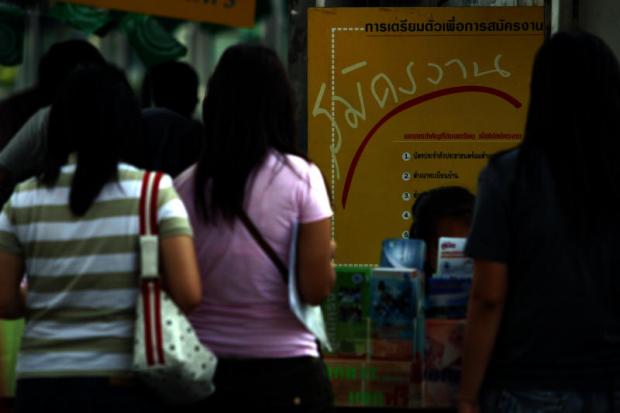
The unemployment rate continued to rise in the second quarter as an influx of new graduates entered the labour market and private investment proved slower than expected.
The National Economic and Social Development Board (NESDB) said yesterday that the unemployment rate rose to 1.22% or 465,000 people in the second quarter from 1.08% and 463,000 people in the year-earlier quarter.
According to the government's planning unit, 39% of the unemployed had university degrees.
But the agency said this is considered a normal occurrence because the working-age bracket usually has a high rate of unemployment in the second and third quarters every year, after which the rate starts to decline as the fourth quarter approaches.
NESDB secretary-general Porametee Vimolsiri said all related agencies must conduct a more in-depth study of how to reduce the unemployment rate among new graduates.
The government's think-tank said the total workforce stood at 38.26 million people in the second quarter, up 0.3% year-on-year, with the number of employed people at 37.53 million, up 0.4% year-on-year.
Mr Porametee said that based on the number of employed people in the second quarter, there was still a positive employment trend during the period.
"There was an increase in the employment rate for the first time in the past four quarters, which was particularly driven by a 6.3% increase in the agricultural sector, thanks to favourable weather conditions, normalised water level in dams and rises in agricultural products that incentivised farmers to expand agricultural activities," he said.
The agricultural sector employed 11.6 million people in the second quarter.
Employment in the non-agricultural sector declined, especially in manufacturing, construction and hotels/restaurants, due to relatively slow business expansion and the fact that employment usually starts once such expansions take place.
Furthermore, the majority of business operators were reported to be trying to use their existing manpower, while some have employed some advanced technologies in production, construction and service.
The non-agriculture sector employed 25.9 million, down 2.1% year-on-year.
Mr Porametee said the private investment recovery was quite slow, while many entrepreneurs have opted for high technology to be used in their manufacturing, construction and services, significantly cutting the number of employees needed.
According to the NESDB, some key labour issues remain to be closely followed up during the rest of 2017, including the impact of weakening crop prices and flooding on employment and income in the agricultural sector, the urgent need to accelerate skill development for workers to meet competency levels required by the labour market, and follow-through on the enforcement of the amended Labour Protection Act and related regulations.
In a related development, the NESDB said household debt in the first quarter totalled 11.48 trillion baht, up 3.1% year-on-year.
The figure accounted for 78.6% of GDP, down from 79.83% in the fourth quarter of 2016, 79.95% in the third quarter of 2016, 80.27% in the second quarter of 2016, 80.61% in the first quarter of 2016, and 81.17% in the fourth quarter of 2015.